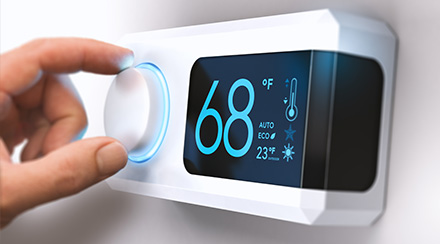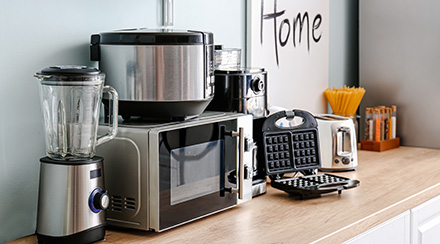How Much Energy Does a Typical House Use?

If you keep tabs on the amount of energy you’re using when you check your utility bills each month, you might be wondering how your energy consumption compares to the typical household.
Every home is a little different, and so are our personal energy habits, so comparing your household to the national average can help put your energy consumption into context.
How Many kWh Does a House Use?
Some homes are powered in part by natural gas and other non-electric energy sources, but many U.S. homes are powered primarily or entirely by electricity. If you check your latest electricity bill, you’ll see that your electricity consumption is measured in kilowatt-hours, or kWh. According to the U.S. Energy Information Administration (EIA), the average electricity consumption for a U.S. household was 10,715 kWh per year in 2020. That’s about 893 kWh per month, or an average kWh per day of about 30.
The full range of household energy consumption is extremely broad, and numerous factors account for why some households consume so much more energy than others. Two of the most significant factors are the type of home – detached homes, duplexes, apartments, etc. – and the geographic region of the home. In general, apartments and attached homes consume less electricity than detached homes and mobile homes, and homes in the southern U.S. consume more electricity than homes in other regions.
The EIA measured each of these categories in a 2015 study, and their data shows how vastly these averages can differ. For example, the average single-family detached home in the South consumed 15,819 kWh that year, compared with just 4,120 kWh for the average apartment in the Northeast in a building with five or more units. The national average in 2015 was about 11,000 kWh.
Comparing your kWh consumption to that of similar homes in your region may be even more helpful than comparing it to the national average, but keep in mind that there are several other elements that factor into how much energy your home uses. Homes that are larger and older tend to use more energy than those that are smaller and newer, and the number of occupants in a home generally adds to the energy consumption. The condition of a home’s windows, doors, roof and insulation, as well as the age and condition of its major appliances, can also make a big difference.
What About Other Energy Sources?

The EIA reports that 58% of U.S. homes used natural gas as an energy source in 2015, and most of that energy consumption went toward space and water heating. This helps account for why electricity consumption is so much higher in the South – Southern homes use more air conditioning, which runs on electricity, while homes in the Northeast comparatively use more heat, which is commonly powered by natural gas in that region.
Only a small share of our natural gas supply is used directly by homes; the residential sector accounted for about 15% of total consumption in 2021, according to the EIA. The largest share – 38% – was used by electrical utilities to generate electricity.
Electricity and natural gas combined to account for 85% of all household energy consumption in 2021, according to the EIA. The remaining 15% comes from a variety of less common sources including heating oil, propane, kerosene, solar energy, geothermal energy and wood burning.
Is Your Energy Consumption Above Average?
If you compare your energy use to similar households in your region and find that yours is a little on the high side, there may be several things you can do to reduce your consumption. You can start right away by changing some of your basic energy habits, like raising or lowering the thermostat a few degrees, hang-drying your clothes on sunny days and making sure to turn off the lights in empty rooms. But if you want to make bigger reductions in your household energy use, you might need to invest in some home maintenance and upgrades:
- Switch to energy efficient appliances. The federal ENERGY STAR program makes it easy to identify the models that meet the highest energy efficiency standards.
- Replace appliances that are older or in disrepair. No major appliances last forever, and outdated or failing appliances could be costing you a bundle.
- Upgrade your insulation. Quality insulation should save energy by keeping warm air in during the winter and hot air out during the summer. You can evaluate the state of your insulation by scheduling a professional home energy audit.
- Seal your home. Cracks and gaps in the walls of your home can undermine even the best insulation, as can cracked and torn weather stripping around windows and doors. Repair these vulnerable spots to eliminate costly drafts.
- Use smart home technology to reduce energy waste. Smart appliances, smart thermostats, motion sensors and other technology can be used to help ensure you’re not wasting energy when your home is unoccupied.
Looking for more ways to reduce your energy use? Read our article on energy-saving tips for more of our best methods to save energy in your home. For seasonal tips, check out our articles on weatherizing your home for summer and weatherizing your home for winter.
Looking for Something Specific?
Select a category to find resources for topics that interest you.
Select Category

Related Articles:

Tips for Improving Your AC and Furnace Efficiency
We share maintenance tips for your heater and AC, and home improvement tips to help you use those systems less.
Read Article
Tips for Saving on Energy in Your Home
If you’re looking to learn more about energy efficiency for home systems and appliances, we’re sharing our favorite energy-saving tips.
Read Article
What Uses the Most Electricity In a Home?
We break down what uses the most energy in your home to give you an understanding of where your energy usage goes and where energy-saving tactics can make the most impact.
Read ArticleHow Much Energy Does a Typical House Use?
If you keep tabs on the amount of energy you’re using when you check your utility bills each month, you might be wondering how your energy consumption compares to the typical household.
Every home is a little different, and so are our personal energy habits, so comparing your household to the national average can help put your energy consumption into context.
How Many kWh Does a House Use?
Some homes are powered in part by natural gas and other non-electric energy sources, but many U.S. homes are powered primarily or entirely by electricity. If you check your latest electricity bill, you’ll see that your electricity consumption is measured in kilowatt-hours, or kWh. According to the U.S. Energy Information Administration (EIA), the average electricity consumption for a U.S. household was 10,715 kWh per year in 2020. That’s about 893 kWh per month, or an average kWh per day of about 30.
The full range of household energy consumption is extremely broad, and numerous factors account for why some households consume so much more energy than others. Two of the most significant factors are the type of home – detached homes, duplexes, apartments, etc. – and the geographic region of the home. In general, apartments and attached homes consume less electricity than detached homes and mobile homes, and homes in the southern U.S. consume more electricity than homes in other regions.
The EIA measured each of these categories in a 2015 study, and their data shows how vastly these averages can differ. For example, the average single-family detached home in the South consumed 15,819 kWh that year, compared with just 4,120 kWh for the average apartment in the Northeast in a building with five or more units. The national average in 2015 was about 11,000 kWh.
Comparing your kWh consumption to that of similar homes in your region may be even more helpful than comparing it to the national average, but keep in mind that there are several other elements that factor into how much energy your home uses. Homes that are larger and older tend to use more energy than those that are smaller and newer, and the number of occupants in a home generally adds to the energy consumption. The condition of a home’s windows, doors, roof and insulation, as well as the age and condition of its major appliances, can also make a big difference.
What About Other Energy Sources?
The EIA reports that 58% of U.S. homes used natural gas as an energy source in 2015, and most of that energy consumption went toward space and water heating. This helps account for why electricity consumption is so much higher in the South – Southern homes use more air conditioning, which runs on electricity, while homes in the Northeast comparatively use more heat, which is commonly powered by natural gas in that region.
Only a small share of our natural gas supply is used directly by homes; the residential sector accounted for about 15% of total consumption in 2021, according to the EIA. The largest share – 38% – was used by electrical utilities to generate electricity.
Electricity and natural gas combined to account for 85% of all household energy consumption in 2021, according to the EIA. The remaining 15% comes from a variety of less common sources including heating oil, propane, kerosene, solar energy, geothermal energy and wood burning.
Is Your Energy Consumption Above Average?
If you compare your energy use to similar households in your region and find that yours is a little on the high side, there may be several things you can do to reduce your consumption. You can start right away by changing some of your basic energy habits, like raising or lowering the thermostat a few degrees, hang-drying your clothes on sunny days and making sure to turn off the lights in empty rooms. But if you want to make bigger reductions in your household energy use, you might need to invest in some home maintenance and upgrades:
- Switch to energy efficient appliances. The federal ENERGY STAR program makes it easy to identify the models that meet the highest energy efficiency standards.
- Replace appliances that are older or in disrepair. No major appliances last forever, and outdated or failing appliances could be costing you a bundle.
- Upgrade your insulation. Quality insulation should save energy by keeping warm air in during the winter and hot air out during the summer. You can evaluate the state of your insulation by scheduling a professional home energy audit.
- Seal your home. Cracks and gaps in the walls of your home can undermine even the best insulation, as can cracked and torn weather stripping around windows and doors. Repair these vulnerable spots to eliminate costly drafts.
- Use smart home technology to reduce energy waste. Smart appliances, smart thermostats, motion sensors and other technology can be used to help ensure you’re not wasting energy when your home is unoccupied.
Looking for more ways to reduce your energy use? Read our article on energy-saving tips for more of our best methods to save energy in your home. For seasonal tips, check out our articles on weatherizing your home for summer and weatherizing your home for winter.
Looking for Something Specific?
Select a category to find resources for topics that interest you.
Select Category

Related Articles:

Tips for Improving Your AC and Furnace Efficiency
We share maintenance tips for your heater and AC, and home improvement tips to help you use those systems less.
Read Article
Tips for Saving on Energy in Your Home
If you’re looking to learn more about energy efficiency for home systems and appliances, we’re sharing our favorite energy-saving tips.
Read Article
What Uses the Most Electricity In a Home?
We break down what uses the most energy in your home to give you an understanding of where your energy usage goes and where energy-saving tactics can make the most impact.
Read Article






